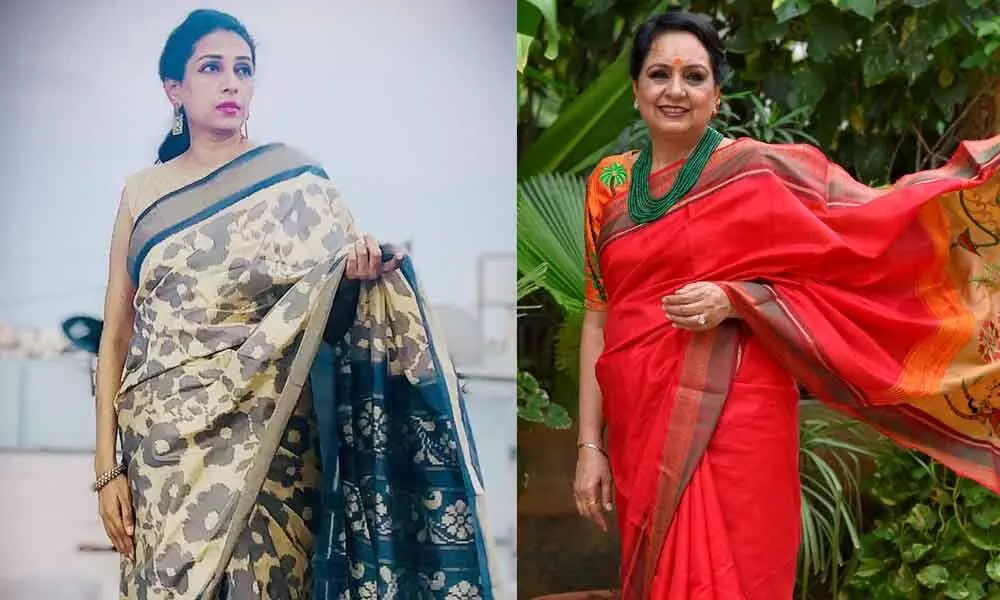Live
- BJP expecting its 'best show in South' on back of PM Modi's popularity, says HM Amit Shah
- Mahabubnagar MP Seat Witnesses Intense Competition among Congress, BJP, and BRS Candidates
- 150 Families from YSRCP Join TDP in Tanakallu Mandal
- Special prayers offered at Dargah during Keshineni Chinni's Nomination
- Dell launches AI-powered commercial PC portfolio in India
- Maha: 5 Vidarbha constituencies records 32.36 pc polling till 1 pm
- Congress, CPI-M not part of INDIA bloc in Bengal: Mamata Banerjee
- Madhubani Saree: The epitome of traditional elegance and modern beauty
- Fire in TTD Forest in Tirumala
- SC dismisses rape survivor's plea seeking action against Kerala judge
Just In
74 women drape in sarees for online meet


74 women drape in sarees for online meet
Seventy four women across three continents draped in sarees, each of a distinct Indian weave, gathered for an online meeting hosted by the Global Sarees Pact, a five year old Facebook group, that promotes the wearing of sarees and weavers, in keeping with the COVID-19 times on the eve of National Handlooms Day
Seventy four women across three continents draped in sarees, each of a distinct Indian weave, gathered for an online meeting hosted by the Global Sarees Pact, a five year old Facebook group, that promotes the wearing of sarees and weavers, in keeping with the COVID-19 times on the eve of National Handlooms Day.
The significance of 74 is the marking of 74 years since India became independent. In earlier years the group joined hands with the Telangana State Handloom Weavers Co-operative Society Limited to showcase new handloom motifs and designs in Sarees by walking the ramp to mark the occasion.
At the virtual meeting the saree enthusiasts decided to wear distinct handlooms from their wardrobe and use new as well as old photographs, to showcase the handlooms pan India on social media. The members hash tagging the drapes as handloom day 1 handloom day 2 are to share the glory of Indian culture and traditional textiles by adding an explanatory note along with the photographs.
The online meeting was attended by select representatives of the Global Sarees Pact - it has nearly 15,000 spread across 15 countries - from around the world on the eve of National Handlooms Day.
"Sadly 2020 has turned out to be an agonizing year with weavers being challenged like never before. The spread of the novel corona virus has pushed them into turbulent times. There is no market for what they weave and things have come to such a pass that many looms have fallen silent," Tejdeep Kaur Menon, senior Administrator of the Group told the members while initiating the discussion.
She pointed out another unwelcome change is that for the modern Indian woman the saree is fast becoming a festive garment to be worn on special occasions. "What we need to do is to make it daily wear just as grandmothers and mothers did for decades," she said.
Veni La disclosed the train of weaves that Global Sarees started over the past year has showcased 74 distinct weaves and embroidery styles of India. "It is a meaningful portrayal of the evolution and the transformational journey of Indian weaves," she explained.
"Though ikkat is woven in some 35 villages in an around Pochampalli in Telangana a connoisseur will be able to spot a saree from one or other place based on the characteristic distinctions. The list of the unique and iconic weaves across India is unending," Tejdeep said.
India is also home to several embroidery styles. The Parsigara saree is one such distinct tradition. When Parsis used to travel to China to barter tea some of the enterprising traders brought back a new genre of artistic embroidery which was very realistic in its depiction of flora and fauna. Legend has it that this was commissioned as a five and half metre saree.
Chikankari is only a generic name for a large number of traditional embroidery styles from Lucknow. It seems that it came to India as part of the culture of Persian nobles in the Mughal court and Noorjehan, the wife of Emperor Jehangir, is associated with its development and growth.
The distinct and more popular Chikankari stitches include tepchi, hool, zanzeera, bakhiya, phanda, bijli, rahet, jaali, murri, karan, Taj Mahal, bulbul and many more.

© 2024 Hyderabad Media House Limited/The Hans India. All rights reserved. Powered by hocalwire.com






